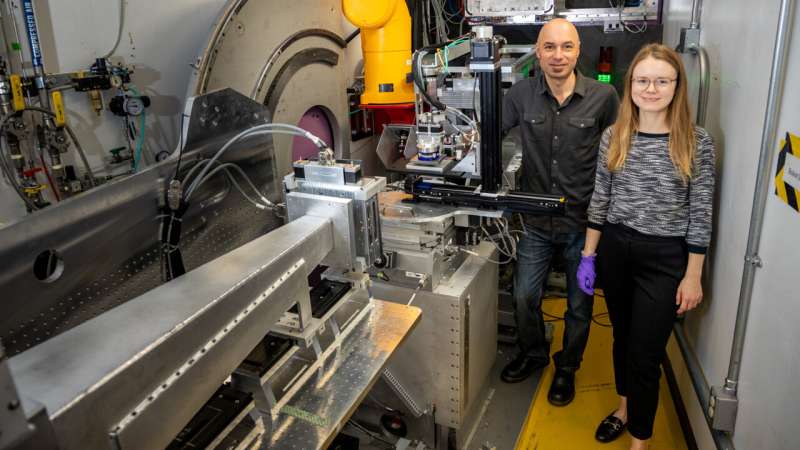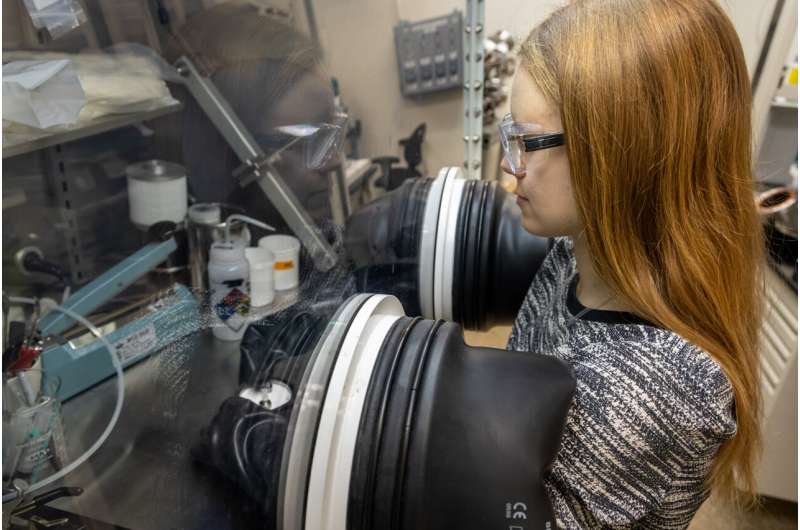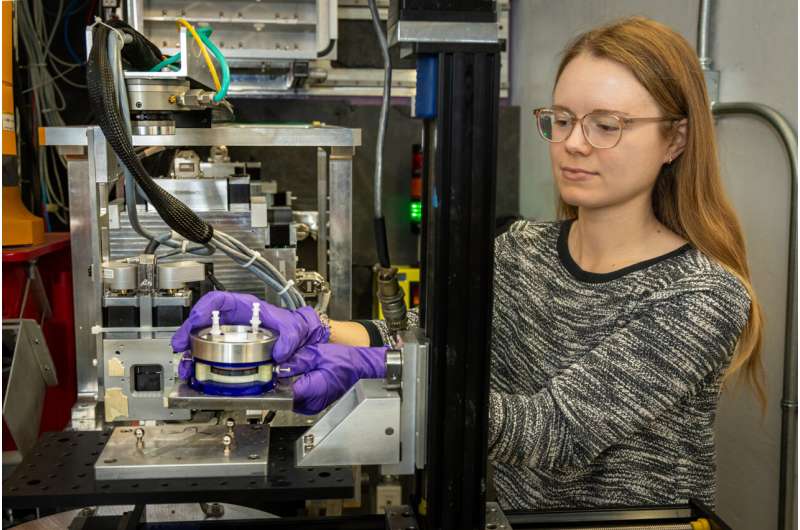This article has been reviewed according to Science X's editorial process and policies. Editors have highlighted the following attributes while ensuring the content's credibility:
fact-checked
peer-reviewed publication
trusted source
proofread
Neutron scattering study points the way to electrochemical for carbon-neutral ammonia

Scientists from Stanford University and the Department of Energy's Oak Ridge National Laboratory are turning air into fertilizer without leaving a carbon footprint. Their discovery could deliver a much-needed solution to help meet worldwide carbon-neutral goals by 2050.
Published in the journal Energy & Environmental Science, the study describes a sustainable electrochemical—rather than chemical—process for producing ammonia, a key ingredient for nitrogen fertilizer.
In essence, the researchers used neutron scattering to understand how cycling an electric current during the conversion of nitrogen to ammonia, also known as the nitrogen reduction reaction, increases the amount of ammonia produced. This process has the potential to enable farmers to convert nitrogen, the most abundant element in our atmosphere, into ammonia-based fertilizers without emitting carbon dioxide.
"Ammonia is critical to food supplies for most of the world's population," said Sarah Blair, a former doctoral student at Stanford's Center for Interface Science and Catalysis who now works at the National Renewable Energy Laboratory in Colorado as a postdoctoral researcher. "As the world population continues to grow, we need sustainable ways to produce fertilizers—especially as warming intensifies."
Industrial fertilizers allow farmers to grow more food on less land. Yet the primary method to create industrial ammonia for more than a century, the Haber-Bosch process, accounts for nearly 2% of all carbon dioxide emissions because of the fossil fuels it requires.
Two percent might not sound like a lot, but we are adding carbon dioxide to the atmosphere faster than the planet can absorb it, making every effort count toward reducing that number. The Haber-Bosch process produces about 500 million tons of carbon dioxide each year, which would require the equivalent of almost all of the federal lands in the U.S. to absorb and store.
Insights from the study could also help scientists understand other processes for making carbon-neutral ammonia for other applications. These could include recycling or recapturing fertilizer runoff before it enters water streams and producing ammonia at seaports for fueling ships. Global shipping produces another 3% of the world's carbon dioxide emissions, and fossil fuel combustion accounts for the largest source of carbon dioxide from human activity.

"You can't improve the design of something if you don't know how it's already working," Blair said. "Neutrons help science evolve by shedding light at the atomic level on certain systems that are impossible to study otherwise."
Blair and Mat Doucet, a senior neutron scattering scientist at ORNL, conducted their neutron experiments on the Liquids Reflectometer instrument at the Spallation Neutron Source. Their aim was to understand the effect of cycling an electric current on the formation of the solid-electrolyte interface, or SEI, in a nitrogen reduction reaction system that produces ammonia using lithium as a mediator.
Understanding SEI formation holds the key not only to unlock the science behind the electrochemical production of ammonia but also to producing better batteries. The study also marks the first use of neutron-based techniques to observe the formation of an SEI layer during this particular electrochemical conversion.
In addition, a singular new neutron technique, time-resolved reflectometry, emerged from the study. This technique allows scientists to slice neutron data into increments of a few seconds, capturing greater detail, much like watching a movie frame by frame. Initially, Blair and Doucet thought the electrochemical changes they observed happened gradually. However, thanks to the new technique, they discovered changes happening in much smaller time increments.
"Processes that appear to be linear might not be linear at all when you look at them more closely," Doucet said. "Getting to that structure as a function of time is the hard part. The technique we developed for this experiment allowed us to do just that."

Discoveries at SNS lay the foundations of knowledge for technological innovations that improve people's daily lives. The technique Blair and Doucet developed opens new possibilities in electrochemistry for SNS users.
Hanyu Wang, ORNL instrument scientist who also works closely with SNS users, said, "These time-dependent experiments will draw scientists who study separation chemistries."
ORNL Neutron Reflectometry group leader Jim Browning added, "Their approach can answer a lot of questions for separation chemistries, batteries, and an entire gamut of different areas of interest, like energy production, energy storage, and conservation of energy."
More information: Sarah J. Blair et al, Combined, time-resolved, in situ neutron reflectometry and X-ray diffraction analysis of dynamic SEI formation during electrochemical N2 reduction, Energy & Environmental Science (2023). DOI: 10.1039/D2EE03694K
Journal information: Energy & Environmental Science
Provided by Oak Ridge National Laboratory





















